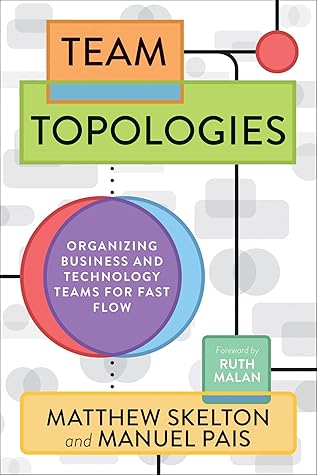More on this book
Community
Kindle Notes & Highlights
Read between
September 22 - November 16, 2023
Periods of technical and product discovery typically require a highly collaborative environment (with overlapping team boundaries) to succeed. But keeping the same structures when discovery is over (established technologies and product) can lead to wasted effort and misunderstandings.
This gap between architecture and team structures is visible across all types of architectures, from client-server to SOA and even microservices. Specifically, that is why monoliths need to be broken down (in particular, any indivisible software part that exceeds the cognitive capacity of any one team) while keeping a team focus,
Fast flow requires restricting communication between teams. Team collaboration is important for gray areas of development, where discovery and expertise is needed to make progress. But in areas where execution prevails—not discovery—communication becomes an unnecessary overhead.
Intrinsic cognitive load—relates to aspects of the task fundamental to the problem space (e.g., “What is the structure of a Java class?” “How do I create a new method?”) Extraneous cognitive load—relates to the environment in which the task is being done (e.g., “How do I deploy this component again?” “How do I configure this service?”) Germane cognitive load—relates to aspects of the task that need special attention for learning or high performance (e.g., “How should this service interact with the ABC service?”)
The first anti-pattern is ad hoc team design. This includes teams that have grown too large and been broken up as the communication overhead starts taking a toll, teams created to take care of all COTS software or all middleware, or a DBA team created after a software crash in production due to poor database handling.
The other common anti-pattern is shuffling team members. This leads to extremely volatile team assembled on a project basis and disassembled immediately afterward, perhaps leaving one or two engineers behind to handle the “hardening” and maintenance phases of the application(s).
Given our skills, constraints, cultural and engineering maturity, desired software architecture, and business goals, which team topology will help us deliver results faster and safer?
The DevOps Topologies reflect two key ideas: (1) There is no one-size-fits-all approach to structuring teams for DevOps success. The suitability and effectiveness of any given topology depends on the organization’s context. (2) There are several topologies known to be detrimental (anti-patterns) to DevOps success, as they overlook or go against core tenets of DevOps.
A lack of ownership over shared code may result from the cumulative effects of several teams working on the same codebase unless inter-team discipline is high.
However, while inter-team communication and dependencies were greatly reduced with teams working on intra-subsystem features, someone still had to keep oversight of the system as a whole and ensure subsystems integrated and interacted according to the desired user experience, performance, and reliability. Therefore, specific roles were created, such as system architects, system owners, or integration leads. Crucially, people in these roles work across the entire project/organization sort of like “communication conduits,” with direct and frequent interaction with feature teams.
Teams have different workloads, priorities, and problems; and generally, there’s too much uncertainty in building and running software systems for a pre-defined schedule to succeed in coordinating multiple teams on the same stream of work. Insisting on this approach inevitably leads to wait times and delays.
there needs to be a split between the responsibility of designing the cloud infrastructure process (by the cloud team) and the actual provisioning and updates to application resources (by the product teams).
The “DevOps team” anti-pattern is a quintessential example. On paper, it makes sense to bring automation and tooling experts in house to accelerate the delivery and operations of our software. However, this team can quickly become a hard dependency for application teams if the DevOps team is being asked to execute steps on the delivery path of every application, rather than helping to design and build self-service capabilities that application teams can rely on autonomously.
As was identified by Jiao Luo and colleagues in research published in 2018, reduced ambiguity around organizational roles is a key part of success in modern organization design.1
Where is the Ops team? Where is the support team? There is no “Ops” team or “support” team in the fundamental topologies, and this is deliberate. The long-lived teams building the systems are very close to the live operation of the systems they are building. There is no “handover” to a separate Ops or support team; even with the SRE pattern (see Chapter 4), the teams are closely aligned. Stream-aligned teams follow good software-delivery practices (like continuous delivery and operability), and they are responsible for live operation, even if very little code is being written. In effect, Ops
...more
A stream-aligned team is a team aligned to a single, valuable stream of work; this might be a single product or service, a single set of features, a single user journey, or a single user persona.
Members of a stream-aligned team feel they have achieved or are in the path to achieving “autonomy, mastery, and purpose,” the three key components of engaged knowledge workers, according to Daniel Pink.
Enabling teams actively avoid becoming “ivory towers” of knowledge, dictating technical choices for other teams to follow, while helping teams to understand and comply with organization-wide technology constraints.


